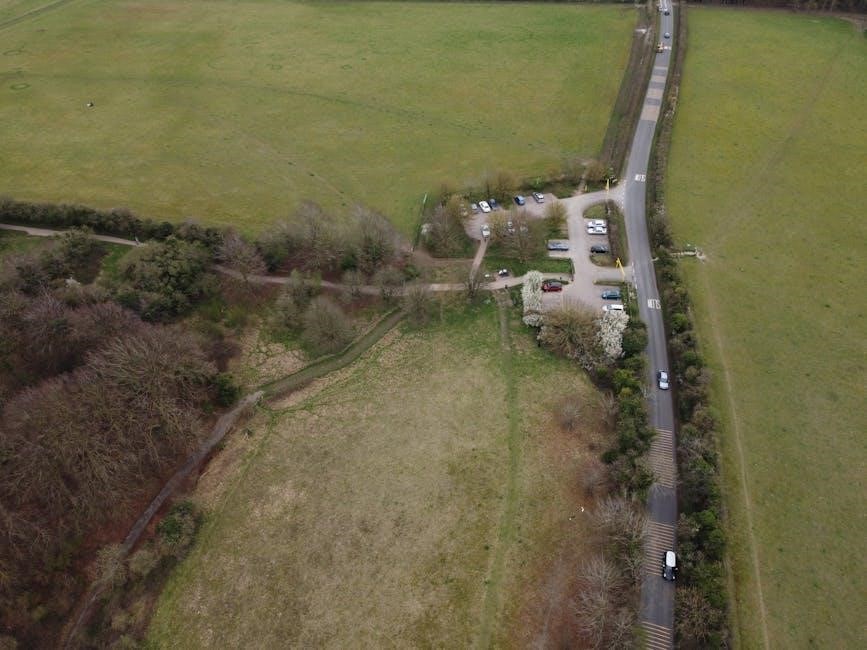The Birds Aren’t Real movement is a satirical conspiracy theory claiming birds are government drones used for surveillance, blending humor with critiques of modern paranoia and misinformation.
Background and Origins
The Birds Aren’t Real movement emerged as a satirical conspiracy theory, initially gaining traction online. Founded by Peter McIndoe and Connor Gaydos, it humorously posits that birds are government drones. The theory claims the U.S. government replaced real birds with surveillance drones between 1959 and 2001, allegedly eradicating over 12 billion birds. This idea, though absurd, critiques modern paranoia and misinformation. The movement blends dark humor with social commentary, challenging trust in authority while mocking conspiracy culture. It has since grown into a viral phenomenon, sparking debates and memes, reflecting Gen Z’s irreverent approach to satire and activism.
Key Figures and Founders
Peter McIndoe and Connor Gaydos are the primary architects of the Birds Aren’t Real movement. McIndoe, often seen with anti-bird signs, became the public face, using satire to critique conspiracy theories. Gaydos, another co-founder, helped shape the movement’s early narrative, blending humor with social commentary. Their collaboration transformed a joke into a viral phenomenon, attracting a devoted following. Their efforts have made them central figures in modern satirical activism, influencing how Gen Z engages with misinformation and political satire through absurd, yet thought-provoking, ideas.

The Conspiracy Theory Explained
The movement claims the U.S. government genocided birds from 1959-2001, replacing them with surveillance drones disguised as birds to monitor citizens, blending satire with societal critique.
Claims of Bird Genocide and Drone Replacement
The movement asserts that the U.S. government systematically exterminated over 12 billion birds between 1959 and 2001, allegedly using a virus to eradicate them. These birds were then replaced with advanced surveillance drones designed to mimic their appearance and behavior. Supporters claim that these drones monitor citizens, with the government aiming to maintain control and gather intelligence. The theory suggests that all birds seen today are, in fact, sophisticated drones, and that natural bird behavior, such as flying in flocks, is programmed to deceive the public. This narrative blends satire with critiques of government surveillance and secrecy.
The Role of the U.S. Government in the Conspiracy
According to the movement, the U.S. government masterminded the bird genocide to replace them with drones for mass surveillance. They allege the government used a virus to eliminate birds, then deployed drones to monitor citizens. These drones supposedly mimic bird behavior and appearance, serving as tools for data collection and control. The government’s alleged involvement includes covering up the genocide and using propaganda to maintain the illusion of real birds. This narrative critiques government secrecy and surveillance, blending satire with paranoia to highlight concerns about privacy and trust in institutions. The movement portrays the government as a manipulative force hiding its true intentions.
Timeline of Events (1959-2001)
The alleged bird genocide began in 1959, with the U.S. government initiating a covert operation to eliminate avian populations. By 1965, natural bird numbers had drastically declined due to a supposedly engineered virus. The government then introduced drone replicas, designed to mimic bird behavior and appearance. Over the next decades, these drones were refined for surveillance purposes. The movement claims the replacement was completed by 2001, with all remaining birds allegedly eradicated. This timeline serves as the cornerstone of the conspiracy, framing the government’s actions as a decades-long scheme to monitor citizens through fake bird drones. The narrative has since evolved into a viral satire.

How the Movement Gained Popularity
The movement gained traction through viral social media campaigns, satirical protests, and its appeal as a humorous critique of conspiracy culture, resonating with younger audiences.
Role of Social Media and Internet Culture
Social media platforms like Twitter, Instagram, and TikTok were instrumental in spreading the “Birds Aren’t Real” movement. Memes, viral challenges, and hashtags turned the conspiracy into a cultural phenomenon. The internet’s ability to amplify absurdity transformed the satire into a shared joke, with users creating fake evidence and humorous content. Online communities embraced the movement as a way to mock conspiracy theories while engaging in light-hearted fun. This digital momentum helped the movement cross into mainstream consciousness, making it a defining example of internet-driven satire and activism.
Real-World Protests and Demonstrations
The “Birds Aren’t Real” movement transcended the internet with real-world protests and demonstrations. In Memphis, Tennessee, a billboard declaring “Birds Aren’t Real” gained attention in 2019. By 2021, supporters protested outside Twitter’s San Francisco headquarters, demanding the platform change its bird logo. These actions, often blending satire with activism, drew media coverage and public curiosity. The protests served as a physical manifestation of the movement’s viral online presence, showcasing its ability to merge humor with social commentary and critique of conspiracy culture. These events underscored the movement’s dual role as both a joke and a statement on modern paranoia.
Memorable Slogans and Propaganda
The “Birds Aren’t Real” movement is known for its catchy and provocative slogans, such as “Birds Aren’t Real” and “Birds Aren’t Real, This is a Drone.” These phrases, often displayed on posters, billboards, and social media, aim to spread the satirical conspiracy theory. The movement also uses humorously edited images and videos to reinforce its claims, creating a blend of absurdity and social commentary. Slogans like “Wake Up, Sheeple!” and “Question Everything” encourage followers to engage with the movement’s playful yet thought-provoking narrative. This propaganda strategy has helped the movement gain viral traction and cultural relevance.
Evidence and Arguments Presented by Supporters
Supporters argue that birds exhibit unnatural behaviors, rarely seen baby pigeons, and strange perching habits, claiming these as evidence of their drone replacement theory.
“Proof” of Bird Drone Surveillance
Supporters claim that birds’ behaviors, such as flying in synchronized patterns or sitting motionless on power lines, are evidence of their alleged drone nature. They argue that real birds would not exhibit such uniformity or precision. Additionally, the rarity of seeing baby pigeons or bird nests is cited as “proof” of a drone replacement. Some point to the lack of visible feathers ruffling in the wind or the unnatural silence of birds as further evidence. These observations, though anecdotal, are presented as conclusive signs of a surveillance drone program.

Alleged Government Cover-Up
Supporters of the “Birds Aren’t Real” movement claim that the U.S. government orchestrated a large-scale cover-up, eliminating over 12 billion birds between 1959 and 2001. They allege that a virus was released to wipe out bird populations, which were then replaced with advanced drone replicas. The government is accused of controlling media narratives, silencing whistleblowers, and manipulating public perception to conceal this alleged genocide. Proponents argue that the transition was designed to appear seamless, with drones mimicking bird behavior to avoid suspicion. This supposed cover-up is central to the movement’s conspiracy theory, framing it as a secretive, decades-long operation.
Questionable Behavior of Birds
Supporters of the “Birds Aren’t Real” movement highlight various bird behaviors they deem suspicious. For instance, the rarity of observing baby pigeons is cited as evidence, suggesting drones lack a natural life cycle. Birds perching on power lines are often noted, with claims that such behavior aligns more with surveillance patterns than natural instincts. Additionally, the inability of birds to fly during severe weather is presented as proof of their mechanical nature, as drones might malfunction under such conditions. These observations are framed as inconsistencies that bolster the theory, arguing that birds’ behaviors are too uniform or controlled to be organic.
Expert Opinions and Counterarguments
Experts dismiss the theory as a baseless hoax, explaining bird behaviors through biology and ecology, while highlighting the movement’s reflection of societal distrust in institutions.
Scientific Rebuttals to the Theory
Scientists and ornithologists dismiss the “Birds Aren’t Real” theory as baseless, citing overwhelming evidence of birds’ biological and ecological roles. Fossil records, evolutionary biology, and observable behaviors contradict claims of bird drones. Birds’ diverse species, mating rituals, and migratory patterns cannot be replicated by drones. Experts highlight that replacing billions of birds with drones would require unimaginable resources and technological capabilities, with no evidence supporting such a massive cover-up. Wildlife experts also note that bird behaviors, such as nesting and feeding, are natural and inconsistent with drone programming. Thus, the theory lacks any scientific foundation or credible evidence.
Psychological Insights into Conspiracy Theories
The “Birds Aren’t Real” movement highlights how conspiracy theories tap into human psychology, offering simplistic explanations for complex issues and fostering distrust in authority. It appeals to a desire for control and understanding in an uncertain world. The theory’s satirical nature attracts those seeking humor or a sense of community. Internet culture amplifies such ideas, as memes and viral content create emotional engagement. The movement also reflects how misinformation can blur the line between satire and belief, demonstrating the power of social influence in shaping perceptions, even when the theory is presented as a joke; It underscores the human tendency to seek patterns and meaning, often leading to the embrace of improbable narratives.
Fact-Checking the Movement’s Claims
The “Birds Aren’t Real” movement’s claims are easily debunked by scientific evidence and logical reasoning. Ornithologists and biologists confirm that birds are living creatures, with extensive research on their biology, migration patterns, and ecological roles. The idea of replacing billions of birds with indistinguishable drones is technologically implausible, as creating such advanced replicas on a mass scale remains beyond current capabilities. Additionally, no credible evidence supports the alleged government genocide or drone replacement. Fact-checking organizations have repeatedly disproven these claims, emphasizing the importance of critical thinking in distinguishing satire from misinformation.

The “Birds Aren’t Real” Drone Field Guide
This guide helps identify and analyze suspected bird drones, detailing their behavior, surveillance capabilities, and distinguishing features to aid in spotting these alleged government drones effectively.
Identifying Drone “Birds” in the Wild
To identify drone “birds,” observe their behavior and physical traits. Look for birds sitting on power lines, avoiding nests, or exhibiting mechanical movements. Note unusual silence or repetitive flight patterns. Drones may lack feathers or display uniform color schemes. Check for reflective surfaces or visible cameras. Be cautious of birds that avoid water or extreme weather. Use binoculars to spot antennae or solar panels. Record sightings for further analysis. Remember, real birds exhibit natural behaviors like nesting and vocalization, while drones may appear rigid or overly synchronized in flight. Stay vigilant and report all suspected drone activity to the movement.
Behavioral Patterns of Surveillance Drones
Surveillance drones, disguised as birds, often exhibit unnatural behaviors. They may hover motionlessly, avoid flocking, or fly in precise, repetitive patterns. Drones tend to appear near government buildings, major events, or areas of high security. They may ignore food sources or predators, focusing solely on surveillance. Some drones mimic bird calls but lack the variability of real birds. Be wary of birds that consistently appear in the same location or follow specific flight paths. These patterns can help distinguish drones from real birds, aiding in their identification and exposure. Stay alert to these anomalies and document them for further analysis.
Case Studies of Suspected Drone Sightings
Several high-profile cases highlight suspected drone sightings. In Memphis, a “bird” remained stationary for hours, sparking suspicion. Another incident involved a “pigeon” near Twitter’s HQ, later linked to protests. These cases, while unverified, illustrate how drone-like behavior raises questions.
How to Spot a Fake Bird
To identify a suspected drone bird, look for unusual behavior. Birds that sit motionless on power lines or exhibit robotic movements may be drones. Check for a lack of natural flapping patterns or feathers ruffling in the wind. Be wary of birds that avoid interacting with their environment or other animals. Additionally, the absence of visible nesting or feeding behaviors can raise suspicions. Finally, note if the bird’s size or shape appears inconsistent with known species. These traits, while not definitive, align with drone-like characteristics highlighted by the movement.

The Technology Behind the Drones
The Birds Aren’t Real movement claims the U.S. Government replaced birds with drone replicas from 1959-2001, engineered to mimic avian behavior for surveillance purposes.
Engineering and Design of Bird-Like Drones
The Birds Aren’t Real movement suggests that surveillance drones are designed to mimic real birds, featuring lightweight, aerodynamic frames and feather-like materials. These drones allegedly incorporate advanced algorithms to replicate bird behavior, such as flight patterns and vocalizations. The design aims to blend seamlessly into natural environments, making them nearly indistinguishable from real birds. Proponents of the theory claim that these drones are equipped with cameras and microphones for widespread surveillance, further fueling the conspiracy narrative. The engineering complexity of these alleged drones underscores the movement’s satirical critique of government surveillance and technological advancements.
Surveillance Capabilities and Purpose
According to the Birds Aren’t Real movement, these bird-like drones are equipped with advanced surveillance technology, including high-resolution cameras, microphones, and data collection systems. Their primary purpose is allegedly to monitor and gather information on individuals and public spaces. The drones are said to operate discreetly, capturing footage and audio without detection. This supposed surveillance is claimed to be part of a broader government effort to control and monitor the population, adding a layer of paranoia to the satirical narrative. The movement portrays these drones as tools of mass surveillance, furthering the conspiracy theory’s dramatic and humorous tone.
Future of Drone Technology
The Birds Aren’t Real movement speculates that future drone technology will become even more advanced, with drones mimicking birds more convincingly. These drones could integrate AI for autonomous operation, enhancing surveillance capabilities. The movement suggests that upcoming advancements in materials and design will make the drones nearly indistinguishable from real birds. Additionally, the theory implies that these drones may incorporate biometric tracking and data collection, further solidifying their alleged role in government surveillance. As technology evolves, the movement predicts that the line between real and fake birds will blur even more, fueling ongoing conspiracy theories and public skepticism.
The Movement’s Impact on Society
The Birds Aren’t Real movement has sparked cultural conversations, blending satire with social commentary, influencing Gen Z humor, and highlighting the power of internet-driven activism and misinformation.
Cultural Significance and Satirical Value
The Birds Aren’t Real movement holds significant cultural value as a satirical commentary on modern conspiracy theories and government distrust. By presenting an absurd premise, it critiques how misinformation spreads and how people engage with it. The movement has become a symbol of Gen Z’s humorous approach to addressing societal issues, using irony to highlight the blurred lines between reality and fiction. Its satirical nature allows it to resonate widely, sparking conversations about the role of government, technology, and the reliability of information in the digital age. This blend of humor and critique makes it a unique cultural phenomenon.
Influence on Gen Z and Millennial Humor
The Birds Aren’t Real movement deeply resonates with Gen Z and millennial humor, which often favors irony, absurdity, and internet-driven absurdism. By embracing a ridiculous conspiracy theory, the movement reflects younger generations’ penchant for using humor to cope with and critique societal anxieties. Memes, viral challenges, and satirical content related to the movement have flourished online, making it a cultural touchstone. This approach to humor not only entertains but also serves as a commentary on the absurdity of modern life, further solidifying its place in the zeitgeist of younger audiences who appreciate its blend of satire and surrealism.
Backlash and Criticism
Despite its satirical nature, the Birds Aren’t Real movement has faced criticism for perpetuating misinformation and undermining trust in scientific facts. Some argue that the movement, while intended as humor, risks normalizing conspiracy theories and blurring the line between satire and reality. Additionally, the movement has been accused of trivializing genuine concerns about government surveillance by framing them in an absurd narrative; Critics also note that the movement’s popularity may overshadow legitimate discussions about privacy and technology, potentially distracting from meaningful dialogue about real-world surveillance issues.
The Birds Aren’t Real movement serves as both a satirical critique of conspiracy culture and a reflection of societal anxieties about surveillance and misinformation, sparking debates about their impact.
Final Thoughts on the Movement
The Birds Aren’t Real movement, while humorous, highlights the blurred lines between satire and belief in the digital age. It critiques the gullibility of modern society and the rapid spread of misinformation. By presenting absurd claims as fact, the movement challenges people to think critically about what they consume online. Its success lies in its ability to merge conspiracy theories with internet culture, creating a viral phenomenon that continues to spark debates about truth and fiction. Ultimately, it serves as a reminder of the power of satire in questioning authority and societal norms.
Lessons Learned from the Conspiracy
The Birds Aren’t Real movement reveals the power of satire in sparking critical thinking about misinformation. It demonstrates how easily absurd ideas can gain traction online, highlighting the need for media literacy. The conspiracy also shows how humor can unite people across political divides, proving that even the most ridiculous theories can have cultural significance. By blending fiction with reality, it challenges individuals to question their beliefs and seek truth. Ultimately, the movement serves as a cautionary tale about the dangers of unchecked conspiracy theories and the importance of verifying information in the digital age.
The Future of Satirical Activism
The Birds Aren’t Real movement offers a blueprint for future satirical activism by using humor to critique societal issues. By leveraging absurdity, it engages younger audiences and sparks conversations about government surveillance and misinformation; The movement’s success suggests that satire can be a powerful tool for social commentary, encouraging others to adopt similar strategies. As technology advances, blending satire with digital media could become even more effective in challenging authority and promoting critical thinking. This approach may inspire new waves of activism that blend humor with advocacy to address complex modern challenges creatively and effectively.
